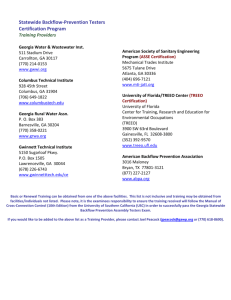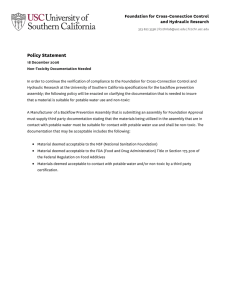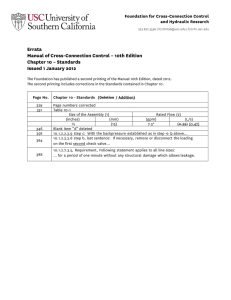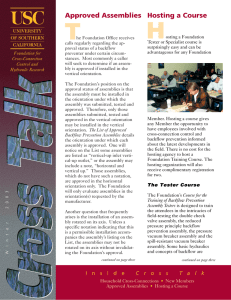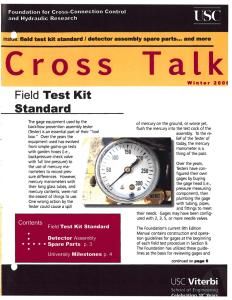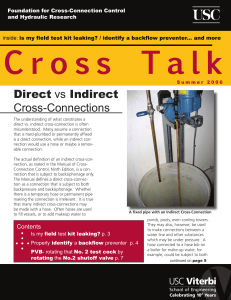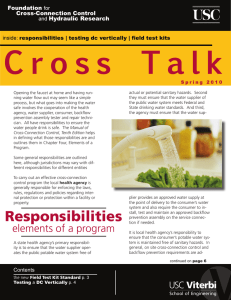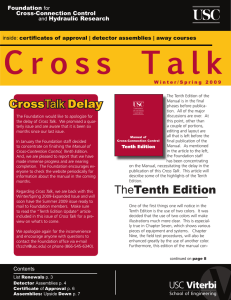tion under certain parameters. For example,
advertisement
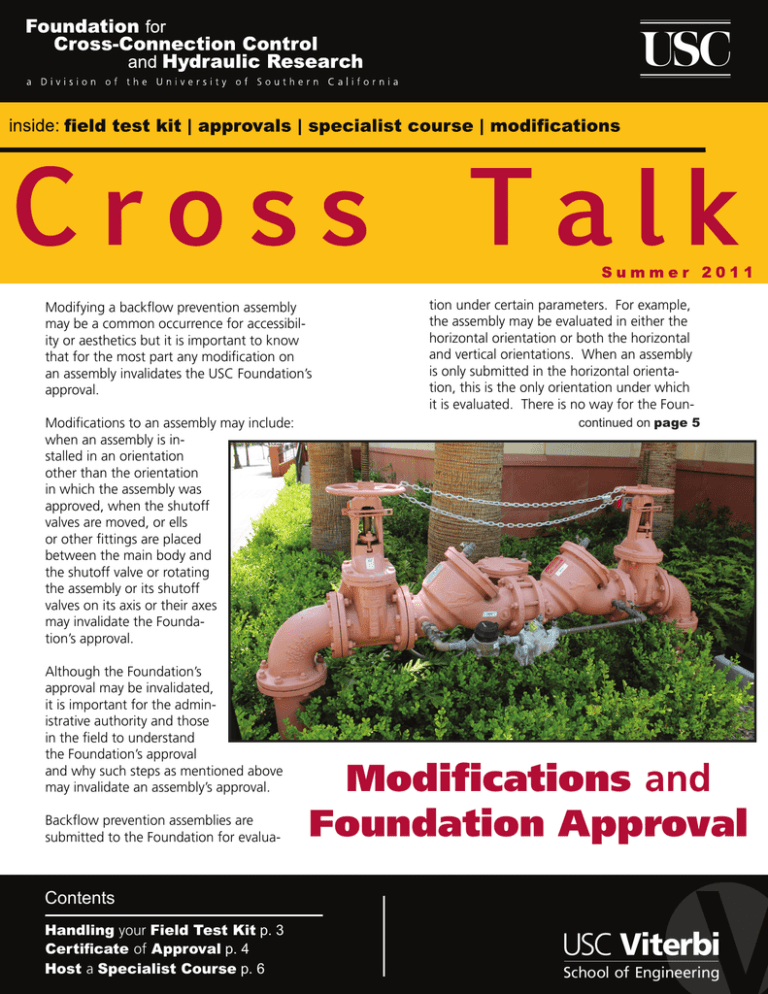
Modifying a backflow prevention assembly may be a common occurrence for accessibility or aesthetics but it is important to know that for the most part any modification on an assembly invalidates the USC Foundation’s approval. Modifications to an assembly may include: when an assembly is installed in an orientation other than the orientation in which the assembly was approved, when the shutoff valves are moved, or ells or other fittings are placed between the main body and the shutoff valve or rotating the assembly or its shutoff valves on its axis or their axes may invalidate the Foundation’s approval. Although the Foundation’s approval may be invalidated, it is important for the administrative authority and those in the field to understand the Foundation’s approval and why such steps as mentioned above may invalidate an assembly’s approval. Backflow prevention assemblies are submitted to the Foundation for evalua- Contents Handling your Field Test Kit p. 3 Certificate of Approval p. 4 Host a Specialist Course p. 6 tion under certain parameters. For example, the assembly may be evaluated in either the horizontal orientation or both the horizontal and vertical orientations. When an assembly is only submitted in the horizontal orientation, this is the only orientation under which it is evaluated. There is no way for the Founcontinued on page 5 Modifications and Foundation Approval Foundation Membership The Foundation’s Membership Program provides many benefits to the Members of the Foundation. These include: a twenty-five percent discount on manuals, twenty percent discount on Foundation Training Courses for any employee of the Member company/organization, the List of Approved Backflow Prevention Assemblies with access to the up-to-the-minute version on the Foundation’s website. Members are encouraged to call the Foundation with technical questions. The Foundation’s Engineering Staff is available to assist Members with the various aspects of field testing backflow preventers, installing backflow preventers and administering their cross-connection control program. Below is a list of those who have become members of the Foundation since the last Cross Talk: Badaly Architects Los Banos, City of BAT & Supply P. D. & J. ENVIROCON Columbia County Water Utility Palomar Backflow Dixie Regional Medical Center PMC Plumbing, Inc. Gilson Engineering Reliable Plumbing & Drain Cleaning, Inc. Gundlach’s Seward, City of - Public Works Dept. Hydro-Tech Irrigation Co. William S. Snyder KP Professional Engineering, P.C. notice about Training Course CEUs After careful consideration the USC Foundation has decided to change its Continuing Education Units offered at its Tester and Specialist Training Courses. Effective immediately the Tester training course will now offer 3.6 CEUs while the Specialist training course will offer 3.7 CEUs. The State of California requires that Water Treatment and Distribution Operators must attend training courses and collect the necessary CEU’s. To qualify to take some of the Grade 3-5 exams the individuals can use “supplemental specialized” training courses. This includes training courses in “backflow”. The State regulations stipulate that these specialized training courses must provide a minimum of 36 contact hours. So neither of our courses will satisfy the State’s requirement. Upon reviewing the requirements for CEU’s, it was determined that many of the hours in the Foundation’s training courses were not being included. The CEU requirements include “assessments” (i.e., written exams, written reports, performance demonstrations, etc.) which we did not fully include when our CEU’s were calculated several years ago. Any members who may have questions about the change please contact the Foundation Office. Cross Talk is published by the Foundation for Cross-Connection Control and Hydraulic Research, a division of the University of Southern California, for Foundation Members. 2011 © University of Southern California. All rights reserved. printed on Page 2 SUMMER 2011 Cross Talk recycled paper Handling your Field Test Kit Properly using a field test kit is an integral part of testing for any tester who is field testing backflow prevention assemblies. It is crucial that the tester know how to use the field test kit and what positions to hold it in during the field test procedure. Failure to properly use the field test kit may result in inaccurate readings. Unused hoses may be wrapped around the field test kit to maintain them at the proper elevation, or the unused hoses may be detached from the field test kit entirely. If the low side and bypass hoses are detached, the tester must be careful not to place their hand over the ports where the hoses would be attached. Caution is needed when operating the high side bleed needle valve while field testing the above mentioned assemblies. Blocking the opening on the low side of the field test kit may restrict the free movement of air into and out of the field test kit. Consequently, readings on the field test kit may be inaccurate. Field test kit position during field testing of backflow prevention assemblies is crucial and noted in chapter nine of the Manual of Cross-Connection Control, Tenth Edition. Not raising the gage to the appropriate elevation may result in inaccurate reading leading to prematurely failing an assembly or passing an assembly which does not meet the requirements for passing the field test. Handling of the field test kit is also vital. When field testing a double check valve assembly, pressure vacuum breaker assembly or spill-resistant pressure vacuum breaker assembly the high side hose attached to the field test kit is the only hose used during the procedure. And, even though the high side hose is the only one used for the field-test procedure, the field test kit continues to read the difference of pressure between the high side and low side. If the low side of the field test kit is restricted or blocked, then the reading will be incorrect. Therefore, the tester must be careful when holding the field test kit. If the tester observes odd readings the tester should verify that the low side of the gage is not blocked and that the field test kit is at the appropriate elevation. If you have any questions about properly using a field test kit while field testing backflow prevention assemblies please contact the Foundation office. g Cross Talk SUMMER 2011 Page 3 Certificate of Approval The Foundation evaluates backflow prevention assemblies to its standards found in the its Manual of Cross-Connection Control, that evaluation is called the approval process. Foundation’s approval process consists of a laboratory and field evaluation. Backflow prevention assemblies that successfully complete the Approval Process receive a certificate of approval. Only the manufacture receives a copy of the certificate. Members, on the other hand, may refer to the List of Approved Backflow Prevention Assemblies to search for backflow prevention assemblies that have successfully completed the Approval Process. The Foundation has received enquires for the certificate of approval for specific assemblies found on the List. The Foundation does not make the certificate available to the general public. All certificates are issued to the assemblies’ manufacturers only. A certificate of approval may be required by a water or health entity before installing a backflow prevention assembly. In most cases referring to the List is sufficient. If requested to, the Foundation may provide proof of approval in a form of a written memo stating that the assembly in question is approved by the Foundation. The certificate of approval is issued on the date the assembly is added on the List. Following the initial approval all assemblies on the List are subject to renewal every three years. And, if granted, the renewal date appears on the List in the column titled, ‘renewed.’ Certificates of Approval are not updated with the latest renewal date. If you have any questions concerning the approval of an assembly please contact the Foundation office. g Laminated Field Test Procedures AVAILABLE NOW For every Manual of Cross-Connection Control, Tenth Edition purchased, members may add a copy of the abbreviated field test procedures for the discounted member price of $8.00, plus shipping. Many manufactures make the certificate available on the Internet via their company websites. Or, the manufacture may be contacted directly and request the certificate of approval. Page 4 SUMMER 2011 Cross Talk modifications and foundation approval: continued continued from page 1 dation to ascertain the specific operational characteristics of an assembly in a specific orientation unless that assembly is actually tested in that orientation. Therefore, when an assembly is tested in the horizontal orientation only, and it successfully completes both the laboratory and field evaluation phases of the approval program, the assembly becomes approved in the horizontal orientation only. If it is installed in a different orientation, the approval is invalidated. It could be that the assembly would work in the vertical orientation but if it’s not evaluated in the vertical orientation, there is no way for the Foundation to confirm that the assembly will actually work unless it is tested in the vertical orientation. A less critical case occurs when a shutoff valve on an approved assembly is rotated. Since the assembly was not evaluated and approved in that configuration the approval would be invalidated. However, the Foundation has determined that flanged assemblies of the 2 ½ inch and larger sizes may have their shutoff valves rotated one bolt hole without affecting the operation of the assembly. The foundation will allow this without the approval status being affected. But even in other situations when the shutoff valves are rotated, it is important to know that the shutoff valves are used for testing and maintenance purposes. The shutoff valves do not contribute to the assembly’s ability to prevent backflow. Therefore, if a shutoff valve is rotated on its axis, the assembly’s ability to prevent backflow is unaffected. However, since this is not the configuration under which the assembly was evaluated the Foundation’s approval would be invalidated, other than in the situation mentioned. The administrative authority may, in such a case, choose to grant a variance to the installer so that the assembly may be installed with rotated shutoff valves. Many administrative authorities will grant this variance because the assembly’s ability to prevent backflow is not affected, even though the approval status is. The Foundation’s approval, in essence, states that a particular assembly in a particular configuration and orientation met specific criteria. It would be poor engineering practice for the Foundation to approve an assembly in an orientation other than that under which it was evaluated. In summary, any change made in the assembly, (including configuration and orientation) since the time it was evaluated and approved by the Foundation, would invalidate the Foundation’s approval. These changes may or may not affect the assembly’s ability to prevent backflow. The local administrative authority may grant a variance for assemblies modified in such a way that would not affect the assemblies’ ability to prevent backflow. g Cross Talk SUMMER 2011 Page 5 Host a Specialist Course Hosting a Foundation Specialist course is easy and can be valuable for any Foundation Member. Hosting a course provides an opportunity for those involved with crossconnection control and backflow prevention in various parts of the country to be trained by the Foundation Staff as crossconnection control specialists. The Foundation staff has offered training courses in Texas, Hawaii, Louisiana, Ohio and other areas. cross-connection control program. Main topics discussed are: Rules & Regulations, Policies & Procedures, Record Keeping, Plan Checks, Public Relations and Site Surveys. Much of the course is dedicated to the site survey to help the attendee assess the degree of hazard at Since the specialist course does not require much equipment or manpower to put forth, the course is ideal for travel to different locations. There is no cost for the hosting agency to host a Foundation Training Course. The hosting organization will receive complimentary registration for two attendees. The hosting agency assists in securing a suitable location for the course and providing some of the classroom needs. It is important to note that a classroom of suitable size and survey locations are necessary to host a specialist course. any water using facility. The course includes a short survey of a facility as part of the examination. Following are the main items to consider in the decision to host a Foundation Specialist Course: Meeting Place: The meeting place should be a room large enough to accommodate approximately thirty (30) course participants. The room should have a blackboard with chalk or a greaseboard with pens, along with being suitable for multimedia presentations. The Specialist Course The Foundation’s Course for the Training of Cross-Connection Control Program Specialists is designed to train the attendees in the various aspects involved in administering a Page 6 SUMMER 2011 Course Materials: The Foundation will provide, for each student, a binder containing a syllabus, a time schedule for the week and several reference materials. Also provided, for each student, will be a current copy of the Manual of Cross-Connection Control. In addition, the contact for the hosting agency should provide the Foundation office with local and state regulations so that the instructors can adjust the course to the legal requirements of the region. The Foundation will provide a ‘‘certificate of continued on page 7 Cross Talk completion’’ for each member of the class who successfully completes the written and performance portions of the final examination. Also, continuing education units (CEU’s) are given to students who attend every day of the course. Specialist course students receive 3.7 CEU’s. Field Survey: The hosting organization needs to locate facilities, which will be suitable for field surveys on Tuesday afternoon and Thursday morning of the class. The facilities should be located nearby the classroom and should have several water uses. There should be at least three separate and diverse water uses located at the facility. Before the site is finalized and the proper permission is sought for the surveys, the hosting organization contact should call the Foundation office and discuss the facility with a member of the Foundation’s engineering staff. In many cases a member of the Foundation engineering staff will preview the proposed survey locations in advance of the class to verify their sutability for this porition of the class. On Thursday morning of the class, the students will then be required to survey the locations to determine the uses of water, whether there are any actual or potential cross-connections and ultimately determine the degree of hazard. A separate location is necessary for an instructor lead pre-survey, on Tuesday afternoon. The Foundation Office is currently in the process of scheduling courses for 2012. If any Member is interested in hosting one of the Foundation’s training courses, please visit the Foundation’s website or contact the office to obtain a detailed hosting outline or discuss the possibility with one of the Foundation’s engineering staff. g Questions and Answers The Foundation receives many questions on a regular basis. The following are typical of the questions most frequently fielded by the Foundation Staff. Does the model number on the backflow prevention assembly have to match the model number on the List exactly? Yes. The model number must match exactly to that on the List of Approved Backflow Prevention Assemblies. Any discrepancies between the model numbers invalidates the assembly’s approval regardless how similar the model numbers are. Do students who attend and successfully complete a USC training course have to return for recertification after a certain number of years? No. The USC Foundation does not offer certification. All USC Foundation courses are for training purposes only. At the end of the course students receive a certificate of completion if they successfully pass the course. Certification is typically done through local county or state agencies. Organizations like the ABPA or the AWWA also offer voluntary certification. If a certificate of completion from a USC Foundation training course is misplaced or lost can the USC Foundation replace the certificate? Yes. Certificate replacements are available for $10. Please contact the Foundation office and have the dates of the course ready to locate the scores for the course. Cross Talk SUMMER 2011 Page 7 Training Courses Upcoming Events Los Angeles, CA 3-7 October 2011 ABPA Western Regional Backflow Conference Las Vegas, NV 26-28 September 2011 Tester Course Los Angeles, CA 9-13 January 2012 Specialist Course Los Angeles, CA 23-27 January 2012 Social Media follow us at twitter.com/uscfccchr become a fan by clicking ‘Like’ on our facebook page facebook.com/uscfccchr Foundation for Cross-Connection Control and Hydraulic Research University of Southern California Kaprielian Hall 200 3620 South Vermont Avenue Los Angeles, California 90089-2531 CA-NV AWWA Annual Fall 2011 Conference Reno, NV 17-20 October 2011 Hawaii Chapter ABPA Conference Honolulu, HI 2 November 2011 Contact Information Phone: 866-545-6340 Fax: 213-740-8399 E-mail: fccchr@usc.edu Website: www.usc.edu/fccchr First Class US Postage PAID University of Southern California
